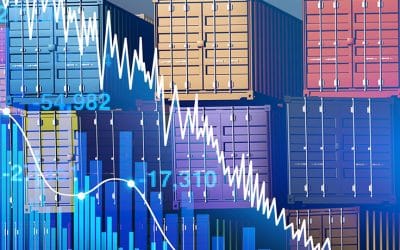Today’s crisis and the long-term perspective

Redacción Mapfre
Let’s start with the obvious: the storm brewing on the horizon. The economy appears to be heading, with remarkable global synchronization, toward a scenario of weak growth accompanied by inflation levels not seen in decades. The supposedly transitory effects on supply caused by a pandemic that continues to persist have combined with those unleashed by Russia’s invasion of Ukraine, which have put additional stresses on supply chains and caused upward pressure on prices of raw materials and energy. On top of that, the tools available to confront and abate this approaching storm appear to be few and far between.
With fiscal policy already worn down to the nub as a result of the need to provide relief and assistance during the pandemic, the best tool at hand – if not the only one – is monetary policy. This is a powerful instrument, but also one that is difficult to calibrate, and unfortunately, using it effectively typically requires erring on the side of excess rather than caution. The risk of acting too timidly creates a situation where interest rates remain too low to control price rises but are high enough to create a recession. This is not being pessimistic - it is simply acknowledging what we have learned from history. And so, the question now is not whether the economy and society in general will have to suffer before overcoming this latest crisis, but rather how much suffering we will have to endure.
The risks are there. Some of the risks are latent, such as the reemergence of COVID-19, the widely foreseen sovereign debt and financial crisis in China, and the effects of climate change that are permeating the economy on a daily basis. Other risks are already evident, with the capacity to deepen over the short term, such as the impact of normalized monetary policy on global debt, hesitant governance in the midst of the geopolitical crisis, and the potential for an economic policy error to drive the world’s economy into a deep recession. The quantitative scenarios – which range from one of stagflation in the developed markets combined with asymmetrical growth in the emerging markets, through to a scenario of generalized recession – would put the dynamics of the world economy at around 3% in 2022 and 2.7% in 2023. However, if the most pernicious circumstances were to materialize, the growth outlook would fall into negative territory.
Yet there is a more complex reality that lies behind these difficulties - a more structural, long-term situation where a sense of emergency is hindering reflection of a sufficiently desirable depth. The crux of the matter is that, once again, we find ourselves on the verge of an economic crisis with the potential to impact the entire planet.
Playing out in a movie we’ve all seen before, the slowdown in growth could lead to a new contraction in income for developed nations and another lost decade for the emerging world, with further postponement of a goal that has already been delayed so many times, namely the social well-being and progress that we had seemed to be so close to finally achieving. But that’s just one aspect of the issue: beyond the quantitative variables, recurring economic crises worsen inequality, not just internally in particular countries but also in society worldwide.
It’s enough to remember that even before the pandemic, 1% of the highest-income population held almost 20% of new wealth generated in the world, while the 50% of the population with the lowest income was receiving just 8% of it. This is much more than just another damned statistic. Behind the numbers, inequality creates frustration in society, and in terms of economics, it gives rise to powerful structural limitations on sustained growth. In the social and political environment, it creates fertile ground for the emergence of populist movements that offer simplistic solutions to those problems, rather than real ones. Taken as a whole, these represent the foundations of a feedback loop for future crises down the line.
Looking toward the future, it is disturbing to see the persistence with which the bases for prosperity are deteriorating, and how insufficiently this problem is being confronted using mental models that are less local and circumstantial and more long term and global. It’s true that the immediacy of a crisis can make it difficult to focus on what lies beyond the storm clouds, but it’s imperative to do just this if we want to hold our course. Typically, it is only after a major crisis has passed that we see a certain vision emerging that seeks to create the foundations for a more stable society and economy, one in which prosperity can become a shared reality so that the kind of tragedy recently experienced does not have to shouldered again. At such times of transition, society takes the form of a constructor who underpins the foundations of a structure after an earthquake has almost razed it to the ground. Perhaps the last time that spirit took hold, when an effort was made to catch a glimpse of the future and act accordingly, was after World War II when the United Nations was created in the wake of the League of Nations, along with the creation of the Bretton Woods financial institutions. That was the last great push to build an institutional framework that could orchestrate a more harmonious equality in the world’s social and economic relationships.
However, despite the fact that since then it has become increasingly clear that the problems we face are no longer merely local in their dimension, that ambitious way of thinking has been growing old alongside the same institutions that were conceived in those days.
Today, the pandemic, climate change, migration caused by war and poverty, the consequences of weak governance, and globalized value chains and the financial system all illustrate how the large-scale problems that can derail our collective future also by their very nature make up a thread that stitches us all together. Nevertheless, we’re still attempting to deal with those problems using threadbare solutions from a bygone era. Waiting for a catastrophe to revive a shared vision of the future could come at a cost that humanity is no longer able to bear.
In view of this, maybe the time has come to return to a way of thinking that focuses not only on the storm clouds looming on the immediate horizon, but also on understanding what gives rise to them. Perhaps humanity, unlike Sisyphus, is unable to bear the eternal agony of pushing an enormous boulder up a hill, just to watch it roll back down before reaching the top, time and time again.
Manuel Aguilera, general director at MAPFRE Economics



